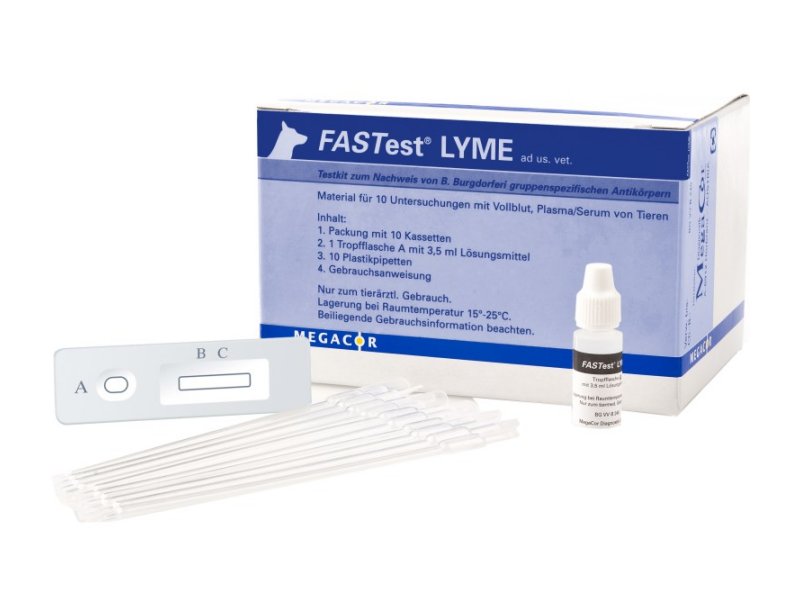Description
Qualitative Detection Of Antibodies Against Borrelia burgdorferi
Test applicable to: Dog
Sample: Whole Blood, Plasma or Serum
FASTest LYME is a rapid immunochromatographic test for the detection of Borrelia burgdorferi IgG antibodies in the anti-coagulated whole blood, serum or plasma of infected dogs.
Test Principle
FASTest LYME is based on a rapid immunochromatographic technique. At the conjugate pad Borrelia burgdorferi sensu lato antibodies in the sample react with mobile gold labelled antibodies. Migrating along the nitrocellulose membrane “lateral flow”, these immune complexes bind to fixed recombinant Borrelia antigens, building up a pink-purple test line (B) in the reaction window. A correct test procedure will be indicated by a second pink-purple control line (C) in the reaction window.
FASTest LYME Product Information – PDF Download
You may also be interested in FASTest BOR in TICK, follow this link
Why Test?
Why is important to test for Lyme Borreliosis?
Lyme disease is caused by the spirochaete bacterium Borrelia burgdorferi sensu lato (genospecies B.b. sensu stricto B. garinii, B. afzelii), which is contracted through bites by ticks (Ixodes spp.). Ticks which are infected with Borrelia are infected up to 30%. Lyme disease is known to affect a variety of mammals, including dogs. Any dogs which are from endemic areas have an antibody prevalence of up to 95% in some cases, however, this can depend on the dog’s ownership, the length of time the dog is outside and the complete sucking time of the ticks.
Symptoms
What are the symptoms of Lyme Borreliosis?
Diagnosis of Lyme disease is based on clinical symptoms and elevated serum antibody titers to Lyme-Borreliosis.
Clinical symptoms, however, can include any of the following:
- Exhaustion and lethargy
- Swollen lymph glands
- Fever
- Arthritis
- Lameness
- Neurological disorders
Early detection of the disease being present is vital to enable successful treatment. The first signs of tick exposition may be present within 2 – 5 months of exposure. Antibody detection is successful if the disease is caught in the early weeks 4 – 6 after exposure if the condition is left to 3 months and more the antibody levels are a lot higher.
A clinical sign of lameness and fever in the animal is a titre increase.
Instructions For Use
Instructions For Use
FASTest LYME Instructions For Use


